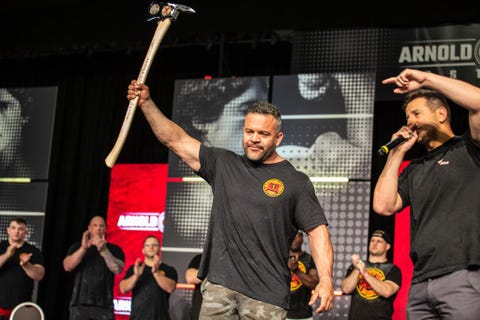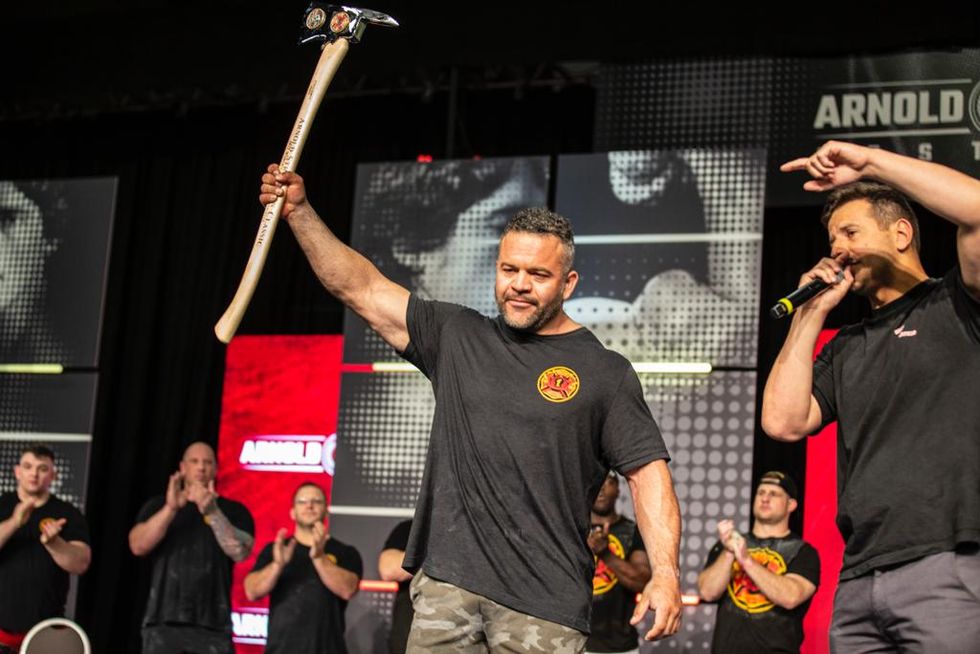
Last month, Daniel Camacho hoisted an ax onstage at the Arnold Sports Festival in Columbus, Ohio—a trophy for being named the World’s Strongest Firefighter, a title he won by deadlifting 525 pounds not once, but 11 times. But the 36-year old almost didn’t compete at all—he’d recently planned to retire from strongman competitions.
“I’ve been competing in the sport of strongman for 11 years, and it really takes a toll—not necessarily your body, but your social life,” Camacho says. “I’m the guy who has to say ’no’ to a lot of things. Like if someone asked me to go out tomorrow night, I can’t, because I have to train the next morning … I don’t think I managed it well, where it didn’t give me enough time for my family.”
Camacho had to fit his training around his responsibilities as a dad to a teenage daughter, and arrange his training around his shifts at the Phoenix Fire Department, where he’s been for six years. Despite the balancing act, Camacho has built an impressive resume in his 11 years of strongman: Besides his World’s Strongest Firefighter title, he’s a two-time Mexico’s Strongest Man (in 2019 and 2020). And the dude is strong—those 525 pound deadlifts were 160 pounds under his max pull of 685 pounds.
He also says he’s found more balance now, and plans to continue competing—including defending his firefighter title at next year’s Arnold Classic. Camacho took a break from saving lives and lifting heavy stuff to talk about how he got started in strongman, how it helps him in his day job, and how regular guys can train like the world’s strongest firefighter.
This interview has been condensed and edited for clarity.
How did you get started in strongman training and competition?
Back in 2011, I joined a gym here in Phoenix that was owned by a strongman guy. And when I joined the gym, I was just like doing bodybuilding workout-style stuff, you know? As soon as I saw these guys moving ridiculous amounts of weights, lifting circus dumbbells, logs, stuff like that, I thought I want to try this! I was hooked. By the end of the year, I was doing my first strongman competition.
The same gym was also owned by a Phoenix firefighter. And that’s how I got to know about the job. I didn’t grow up thinking “I want to be a firefighter when I’m when I’m grown up.” But I got to meet a bunch of firefighters there. They used to go and train, and I got to talk to them about the job and what they do and the camaraderie aspects of it, the family aspect of it. And that’s what got me interested in looking into the job. And then I got lucky: I took the test one time, and it took me three years to get hired. Some guys wait as long as eight years, because there’s a lot of people applying for not very many positions.

Courtesy of Daniel Camacho
How does the strongman training help on the job as a firefighter?
Strongman is always lifting odd objects. You’re not always necessarily lifting a balanced barbell—you’re lifting stones, logs, really heavy blocks.
It’s the same on the job. Let’s say you’re picking up a patient. Their body is not perfectly balanced. Or let’s say we were on a fire and we have to do a forced entry on a door. Obviously, being stronger allows me to do that job easier. When we’re pulling hoses, . all of these things are heavy and awkward and hard to deal with, especially when we’re fighting a fire and there’s a hose under charge, the pressure with the water makes it hard to manage.
How does your training fit into your shifts at the firehouse? Are you able to train there, or do you always have to train elsewhere?
I train five days a week. So whether I’m on shift there or at the gym, I’m going to train. You know, training at the station does come with its difficult things because when the tones [alarms] go off and we have a call, I have to stop. So, you know, it changes things. Say I’m working on deadlifts and I’m working to a heavy deadlift. And then the tones go off, I don’t have the luxury of just continuing. So then when you come back, you basically are cold and you have to re-warm up and then start all over again. But yes, the benefit of the department does provide us with a gym at every station. And so we’re fortunate to get to train while at work. And I do bring some of my strongman equipment every now and then when I need it, depending on what I’m preparing for. And the guys at the station are actually very supportive and they understand the work that I’m putting into this and the focus I have on this.
You mentioned deadlifts there—and you won the Arnold competition with 11 reps of 525. What’s your deadlift day look like?
It depends on what I’m training for. Right now, I’m focused on strength. So last week I did 10 sets of doubles (two-rep max sets) on deadlift with a pause below the knees. So basically you lift the weight, you stop below your knees for a couple seconds, and then you explode from there and finish the lift.
After that, I spend a lot of time on accessory work for the back—extensions, dumbbell rows, lat pulldowns. I use stricter form, and do 4 sets of 10 to 12 reps of each.
I always finish up with some core exercises. I really like the ab wheel. And that day I did dragon flags. Four sets of 20 on the wheel, and I believe it was four sets of 12 on the dragon flag.

Courtesy of Daniel Camacho
I saw you doing some sled work on Instagram the other day … how does cardio fit in to your training?
I can’t just be strong. I have to have conditioning as well. [In strongman,] you’ve got to push the cardio aspect into lifting. You don’t have to be this monster guy that’s 300 pounds and super strong to be good at strongman. In this competition that I won [at the Arnold], I really won because I had better conditioning than some of the other guys. Many of those guys were bigger and stronger than me. They didn’t have the stamina to do deadlifts for reps, or max distance sandbag carry. All of those event, if you think about it, have a lot of conditioning involved—not just strength.
So in the competition, yes, I had the strength to lift 525. But I needed the conditioning to do it for as many reps as possible. The weight never felt heavy. It’s more your lungs and your muscles start getting fatigued because you can’t breathe very well and you’re moving a pretty big amount of weight. Having good conditioning let me push through and keep going.
On that day [with the sled], I had already done a bunch of leg work, and my legs were super sore and destroyed. And then we finished with every-minute-on-the-minute sled pushes for 10 minutes. It was actually light. Only 90 pounds on it.
You’re continuing with your sport after considering quitting—and trying to defend your title as you get towards your 40s. What do you think guys need to add to their training as they hit those ages to keep reaching their own goals?
Put some focus on nutrition. You can’t be the guy that’s always eating burgers or fried chicken all weekend and think you’re healthy. You have to have fun, yes. But you have to be conscious that at least five days of the week you’re focusing on your health.
And what do they need to subtract?
You’ve got to stop telling yourself ‘I’m too old for this.’ When I was [lifting] in my late 20s, it was, ‘oh, wait until you get into your 30s.’ And now all I hear is, ‘oh, wait until you get into your 40s.’ No, man. There’s a gym here that I used to go to, and there is a gentleman there that is in his late 70s, and he’s still there deadlifting somewhere around 400 pounds. So that’s my goal. I want to get to be an older age and still be able to go to the gym and lift. Now, obviously, I might not be able to lift what I can now, but that doesn’t mean that I can lift. People need to stop telling themselves, ‘I’m too old for this.’
This content is created and maintained by a third party, and imported onto this page to help users provide their email addresses. You may be able to find more information about this and similar content at piano.io
